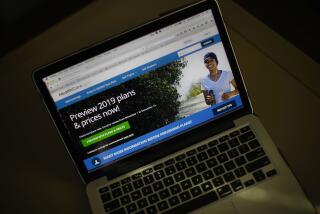Gap in Health Coverage Hits âNear-Elderlyâ
WASHINGTON â At age 56, Carla Everett is about to lose her medical insurance, a terrifying prospect for someone with a blood disease that requires twice-monthly transfusions that cost more than $2,000 each.
For decades, she was covered by her husbandâs employer-provided policy. But Wilson Everett, an electrical engineer, developed severe muscular dystrophy seven years ago and now, at age 59, is enrolled in Medicare. But the federal insurance program for the elderly and disabled doesnât cover spouses younger than 65.
Because of her disease--which was diagnosed last year--Carla Everett is now considered disabled. She also will become eligible for Medicare, but only after a requisite two-year waiting period. Until then, she will have no insurance once her policy expires at the end of June. To prepare for the two-year gap, the Richardson, Texas, woman is eyeing her life savings--and trying to stretch her transfusion sessions to once every three weeks.
âI guess weâll just eventually go broke. Itâs a life-or-death situation,â Wilson Everett said. âWeâve called probably over 100 insurance companies, but no one will touch her.â
Carla Everett is far from alone.
More and more Americans, for a variety of reasons, are losing health insurance in the decade before they qualify for Medicare at age 65.
âThere are many more uninsured than just a few years ago,â said analyst John Rother of the American Assn. of Retired Persons.
In fact, people between the ages of 55 and 64 are losing coverage faster than any other age group. It is an ominous but little-recognized phenomenon at a time when Congress and President Clinton are poised to spend $16 billion during the next five years to expand coverage to the nationâs 10 million uninsured children.
Many of the estimated 2.83 million uninsured Americans in the 55-to-64 age group are early retirees whose former employers increasingly are reneging on a promise to cover them until age 65--an unanticipated consequence of the massive corporate downsizing in recent years. Others, like Carla Everett, are under-65 spouses of Medicare beneficiaries. Some simply hold jobs that donât come with health insurance.
Whatever the reason, the plight of the ânear-elderlyâ poses significant challenges to long-term efforts to overhaul Medicare and to keep it from going bankrupt as unprecedented waves of baby boomers begin to enter the program early in the 21st century.
For one thing, one of the most obvious fixes--raising Medicareâs eligibility age--would further swell the ranks of the uninsured, possibly by hundreds of thousands.
Like the Everetts, most older uninsured Americans have enough assets to make them ineligible for Medicaid, the state-federal health program for the indigent. But few can afford to buy individual policies without feeling the pinch, because such coverage is extraordinarily expensive.
Because older people are more prone to disease, insurers charge them steep premiums--hundreds of dollars a month in some regions. In extreme cases, premiums can range as high as $1,000 a month.
âIf youâre 62 and uninsured, good luck on buying insurance,â said one Labor Department analyst. âWhoâs going to sell you a policy, especially if youâve got a serious medical condition?â
Not surprisingly, many ânear-elderlyâ who become uninsured simply stay that way until they reach 65.
But as these Americans join the growing ranks of the uninsured, experts believe, they begin to behave much like the other 40 million or so people who lack insurance: They tend to neglect preventive care and may, like Carla Everett, postpone or forgo needed treatment.
As a result, by the time they finally enroll in Medicare--and belatedly receive care--their conditions may have deteriorated so much that their bills will be higher than they otherwise might have been.
Those increased expenses inflict yet another financial burden on a program whose hospital trust fund, as it is, is projected to go bankrupt shortly after the turn of the century.
âThis is one of the biggest public policy questions of the early 2000s,â said John Erb, an analyst with Foster Higgins, an employee benefits consulting firm.
*
âPeople just havenât focused in yet on the fact that this is happening,â said Marilyn Moon, an Urban Institute analyst and a Medicare hospital fund trustee.
No single study fully quantifies the problem of uninsured older Americans and its consequences. But research efforts are beginning to shed light on various aspects of the trend. Together, they form what analysts say is an emerging problem that cannot be ignored when policymakers contemplate long-term reforms for Medicare.
A February study by the Urban Institute, for instance, found that the proportion of employers providing health benefits to their early retirees is dropping dramatically. In 1985, 75% of full-time workers in large and mid-sized firms had the option to continue their medical insurance into retirement; by 1993, only 52% could do so.
For most uninsured 55- to 64-year-olds, âthe high cost of private, non-group coverage makes it unaffordable,â said Pamela Loprest and Cori Uccello, authors of the Urban Institute study.
A Labor Department study in 1995 put the problem this way: In 1988, 44% of early retirees had health insurance from a previous employer; by 1994, only 30% enjoyed such a benefit. Moreover, even the insured early retirees are facing ever-rising premiums.
*
Even more alarming, analysts warn, the trend toward diminishing coverage for early retirees may be accelerating, with more employers either cutting back on benefits or terminating coverage altogether.
That decline appears especially precipitous among those who worked for firms with 5,000 or more employees. In 1993, 71% of large employers covered early retirees; by last year, the percentage was down to 63%, Erb said.
âIf current workers are skeptical about their prospects of receiving future Medicare benefits, they should be doubly skeptical about their prospects of receiving the employer-sponsored retiree medical benefits they are being promised today,â said Sylvester J. Schieber, vice president of Watson Wyatt, an international research and information center.
In another study, the private Employee Benefit Research Institute concluded that 13% of the estimated 21.1 million people in the 55-to-64 age group lack health insurance. That translates to about 2.83 million people with no coverage.
At the same time, the entire group of the ânear-elderlyâ will increase from 8% of the U.S. population in 1995 to 12.9% by 2020, which may further increase the ranks of the uninsured, according to Paul Fronstin, the Employee Benefit Research Instituteâs research director. Put another way, since Jan. 1, 1996, baby boomers have been turning 50 at the rate of eight per minute and will continue to do so for the next 10 years, demographers say.
*
The increasing number of uninsured among the ânear-elderlyâ is especially ominous for women, who disproportionately have older spouses.
According to the benefits instituteâs data, 61.3% of ânear-elderlyâ men in 1995 had employer-provided coverage in their own name, while 9.5% were covered as a dependent. By contrast, only 40.3% of ânear-elderlyâ women had workplace-based health insurance in their own name, while 22.9% were covered as a dependent.
One way to reduce the number of uninsured among 55- to 64-year-olds is to allow them to âbuy intoâ Medicare, experts say.
âItâd make a lot of sense because itâd be much cheaper,â said Rother of the AARP.
A model for this approach would be Social Security, which provides reduced benefits for early retirees, said Gail Wilensky, former administrator of the Health Care Financing Administration, which runs Medicare.
(In his controversial health care reform agenda of 1993-94, Clinton proposed a specific solution to the problem of early retirees losing medical insurance. But that proposal--for the government to pick up 80% of the premiums of such coverage--died along with the entire reform plan.)
The creative use of tax credits and tax subsidies also could provide potential answers to the problem, Erb said.
A partial solution would be to extend the 18-month limit during which a person may keep his or her coverage by converting to an individual âCOBRAâ policy after leaving a group plan. Such an option, however, typically requires premium payments of at least 102% of the total cost of a policy, with the individual paying it all.
That approach could help someone like Carla Everett, reducing the length of time during which she would be uninsured. Everettâs COBRA policy, for which she pays $238 a month, expires at the end of June.
In the meantime, Everett, who worked as an administrative assistant for small businesses in suburban Dallas, can only hope that her transfusions and other medical treatments in the next two years will not exhaust the life savings she and her husband have accumulated. Starting in July, the cost to her of each transfusion will skyrocket from a $10 co-pay to the full expense of $2,250.
âIâm not eligible at the county hospital because weâre not destitute,â Everett said. âBut it may not be long till the little bit of money in our 401k and IRA are gone. Then Iâll be eligible.â
More to Read
Inside the business of entertainment
The Wide Shot brings you news, analysis and insights on everything from streaming wars to production â and what it all means for the future.
You may occasionally receive promotional content from the Los Angeles Times.










